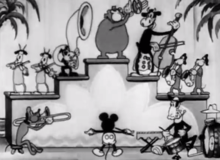Blue Rhythm
Blue Rhythm is a 1931 American animated short film directed by Burt Gillett, produced by Walt Disney Productions and distributed by Columbia Pictures. It was the 31st short to star Mickey Mouse, the 7th of that year.[3] The plot focuses on a multifaceted performance of W. C. Handy's "St. Louis Blues." The film features the voices of Walt Disney as Mickey and Marcellite Garner as Minnie Mouse.
| Blue Rhythm | |
|---|---|
 Mickey directing the jazz band in the second half of the film | |
| Directed by | Burt Gillett |
| Produced by | Walt Disney |
| Starring | Walt Disney Marcellite Garner |
| Music by | W. C. Handy |
| Animation by | Ed Benedict (assistant), Charlie Byrne, Johnny Cannon, Les Clark, Jack Cutting, Joe D'Igalo, Norm Ferguson, Hardie Gramatky, Jack King, Dick Lundy, Tom Palmer, Harry Reeves, Cecil Surry, Frank Tipper, Frenchy de Tremaudan, Rodolfo "Rudy" Zamora[1] |
| Color process | Black-and-white |
Production company | |
| Distributed by | Columbia Pictures |
Release date |
|
Running time | 7 minutes |
| Country | United States |
| Language | English |
Synopsis
The concert opens with Mickey on piano. His shadow is cast dramatically on the curtain as he plays a classical interlude. Soon he transitions into a ragtime version of "St. Louis Blues." Minnie struts onstage and sings the verse "I hate to see that evening sun go down..." with Mickey accompanying. Soon an unseen band takes over the accompaniment and Mickey joins Minnie; the two mice dance and scat sing two more verses.
As Mickey and Minnie exit stage right, the curtain rises to reveal the band – Pluto on trombone, two goats on violins, a Scottish Terrier on sousaphone, a pig on the cornet, Clarabelle Cow on a double bass, two Dachshunds on saxophones, and Horace Horsecollar on a drum set and xylophone; Mickey reappears through a stage elevator to conduct. After several interruptions, Mickey plays a clarinet and parodies jazz bandleader Ted Lewis;[4] the performance is based in part on the Ted Lewis Band's 1926 recording of "St. Louis Blues".
As the band plays the final notes of the climatic finale, they collectively jump on the bandstand and cause it to collapse. They reemerge from the debris to deliver a final "Yeah!" to the audience.
Voice cast
- Mickey Mouse: Walt Disney
- Minnie Mouse: Marcellite Garner[5]
Reception
Variety (March 8, 1932): "No story to this, but it needs none to get it over. Opens with Mickey at the piano pounding out a number, with Minnie rather spoiling it with the falsetto singing that is considered necessary for cartoon characters. A short dance and then a break to a stage jazz band for the usual trick stuff, but well done and in excellent synchrony. Cartoon work overlaid on a capital musical program."[6]
Releases
- 1931 – Original theatrical release
- 1998 – Ink & Paint Club, episode #44 "Musical Mickey" (TV)
- 2002 – "Walt Disney Treasures: Mickey Mouse in Black and White" (DVD)
See also
External links
- Blue Rhythm at The Encyclopedia of Animated Disney Shorts
- Blue Rhythm at the Big Cartoon Database
- Blue Rhythm on IMDb
- Blue Rhythm at the Disney Film Project
References
- "The Encyclopedia of Disney Animated Shorts". Blue Rhythm. Archived from the original on 24 November 2012. Retrieved 27 April 2012.
- Kaufman, J.B.; Gerstein, David (2018). Walt Disney's Mickey Mouse: The Ultimate History. Cologne: Taschen. ISBN 978-3-8365-5284-4.
- Lenburg, Jeff (1999). The Encyclopedia of Animated Cartoons. Checkmark Books. pp. 108–109. ISBN 0-8160-3831-7. Retrieved 6 June 2020.
- Smith, Dave (2006). "Blue Rhythm". Disney A to Z: The Official Encyclopedia (3rd ed.). New York: Disney Editions. pp. 80–81. ISBN 0-7868-4919-3.
- Hischak, Thomas S. (2011). Disney Voice Actors: A Biographical Dictionary. McFarland & Company. p. 249. ISBN 978-0786462711. Retrieved 15 February 2020.
- "Talking Shorts". Variety: 14. March 8, 1932. Retrieved 23 February 2020.